Abstract
OBJECTIVE: To determine factors that influence medical student selection of internal medicine residency programs by ethnicity and gender. DESIGN/SETTING: A cross-sectional mailed survey of graduating medical students applying to four residency programs in 1999. MEASUREMENTS: A five-point (5=most important) Likert scale was used to evaluate factors and included 14 items on location characteristics, 20 on program features, six on recruitment, three on future plans and three on advising. RESULTS: Of 2,820 surveys, 1,005 were completed (36%). The most important factors to applicants were house staff morale (mean +/- SD, 4.5 +/- 0.7), academic reputation (4.5 +/-0.8), and positive interview experience (4.1 +/- 1.0). Women rated gender diversity of faculty (3.3 vs. 2.3, p=0.0001) and house staff (3.3 vs. 2.5, p=0.0001), location of residency program near spouse (4.2 vs. 3.9, p=0.0001) or spouse's job (3.8 vs. 3.5, p=0.0002) and emphasis on primary care (2.9 vs. 2.4, p=0.0001) more highly than men. Minority applicants were more likely than whites to identify the following factors as more important: ethnic diversity of patients (3.8 vs. 3.4, p=0.008), house staff (3.3 vs. 2.4, p<0.0001) and faculty (3.1 vs. 2.3, p<0.0001); service to the medically indigent (3.8 vs. 3.3, p=0.004); feeling of being wanted (3.8 vs. 3.4, p=0.002); and an academic environment supportive of ethnic minorities (3.5 vs. 2.3, p<0.0001). CONCLUSIONS: Location and program factors are most important in influencing decisions to choose a residency program. However, women and minority applicants also place significant importance on family and diversity factors. Programs need to consider differential factors in recruitment of diverse students.
Full text
PDF
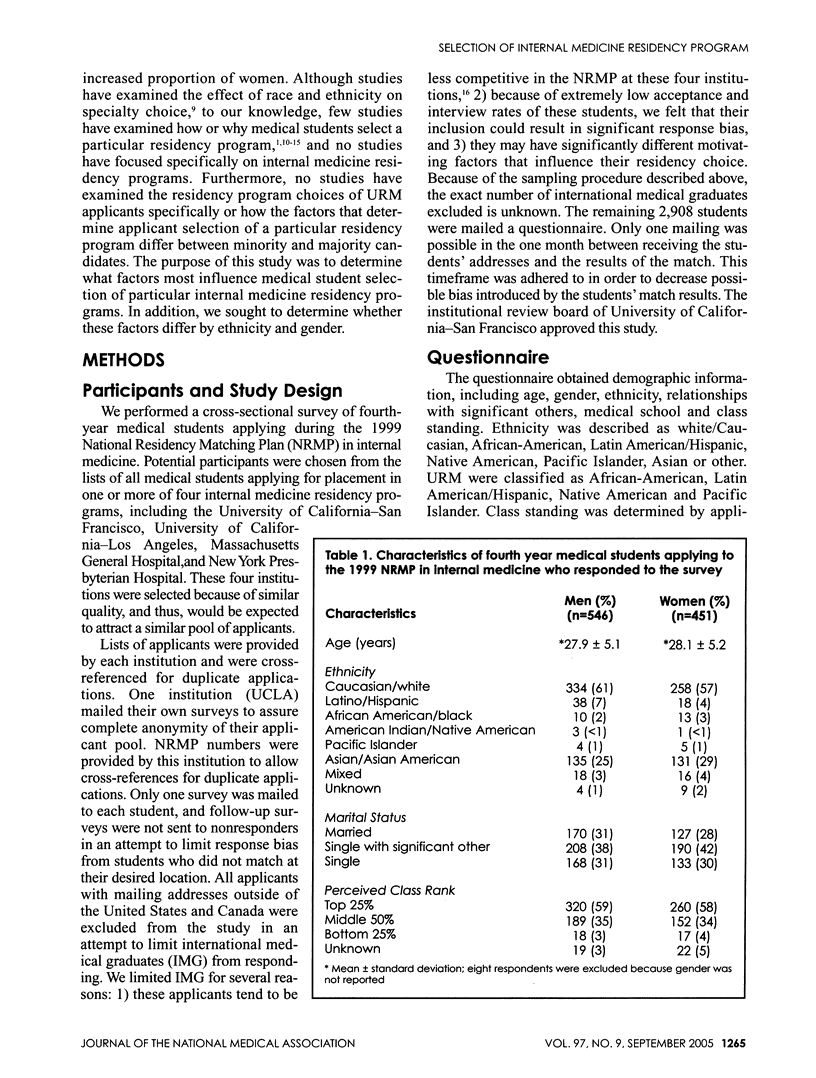
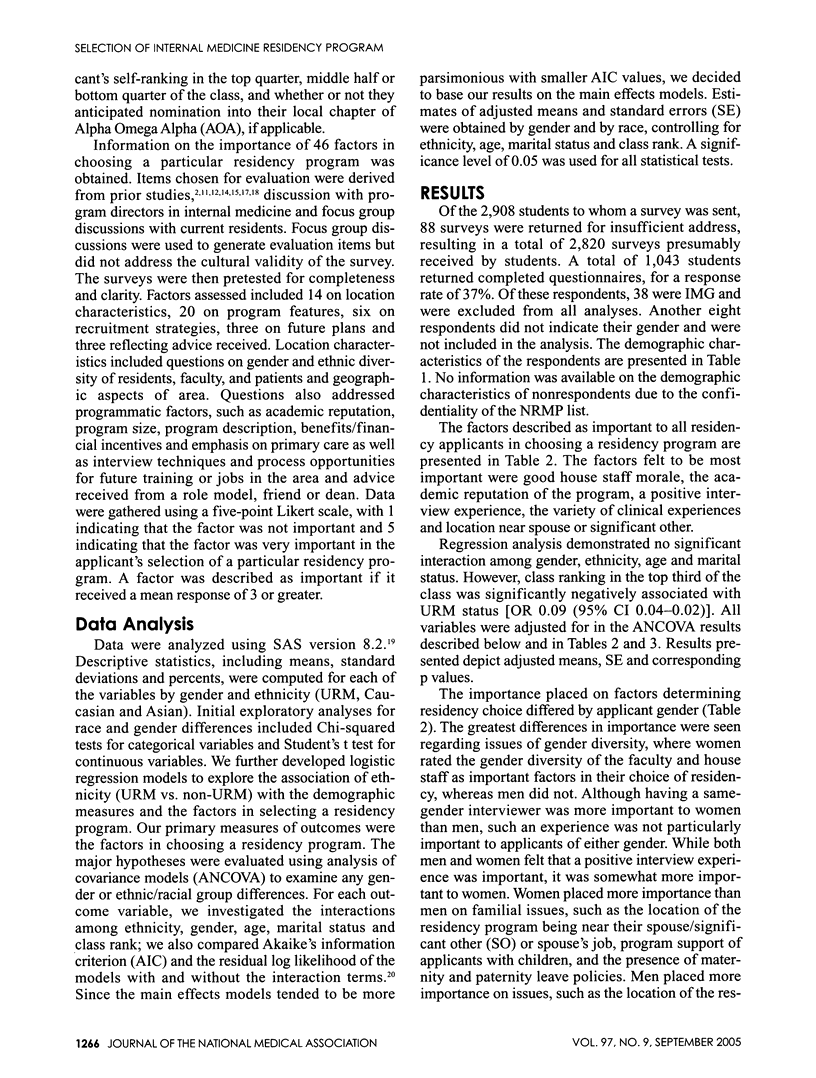
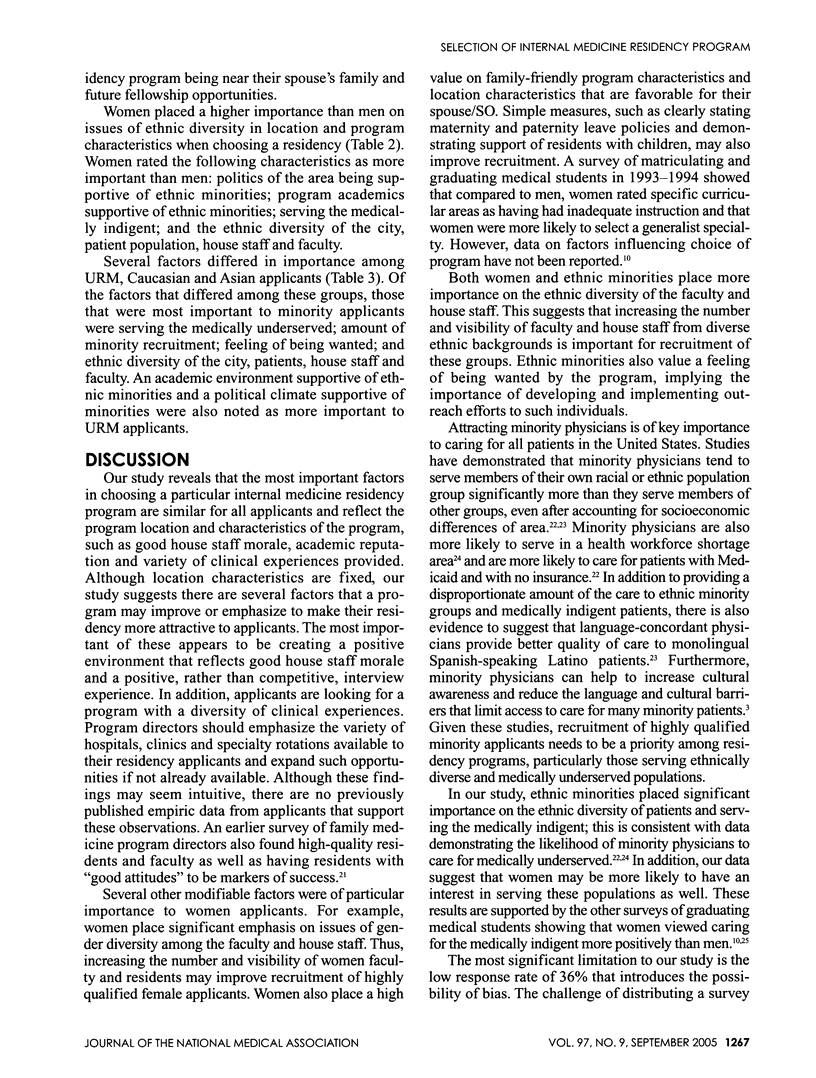
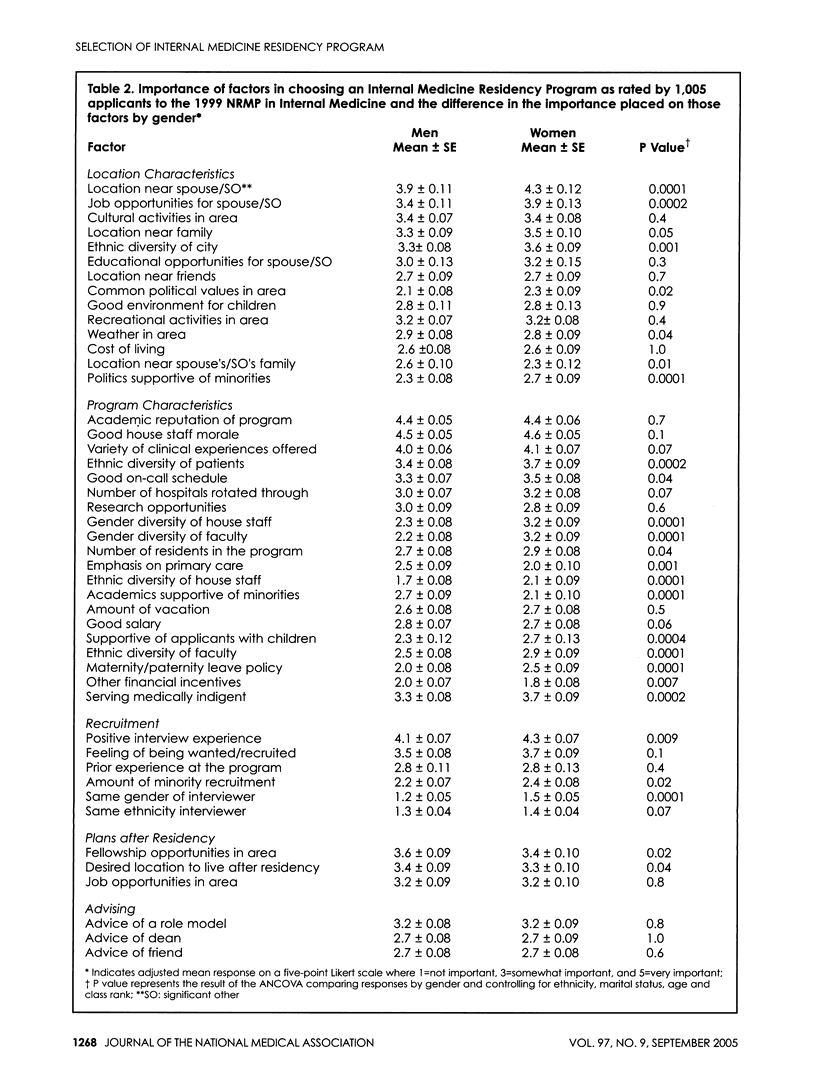

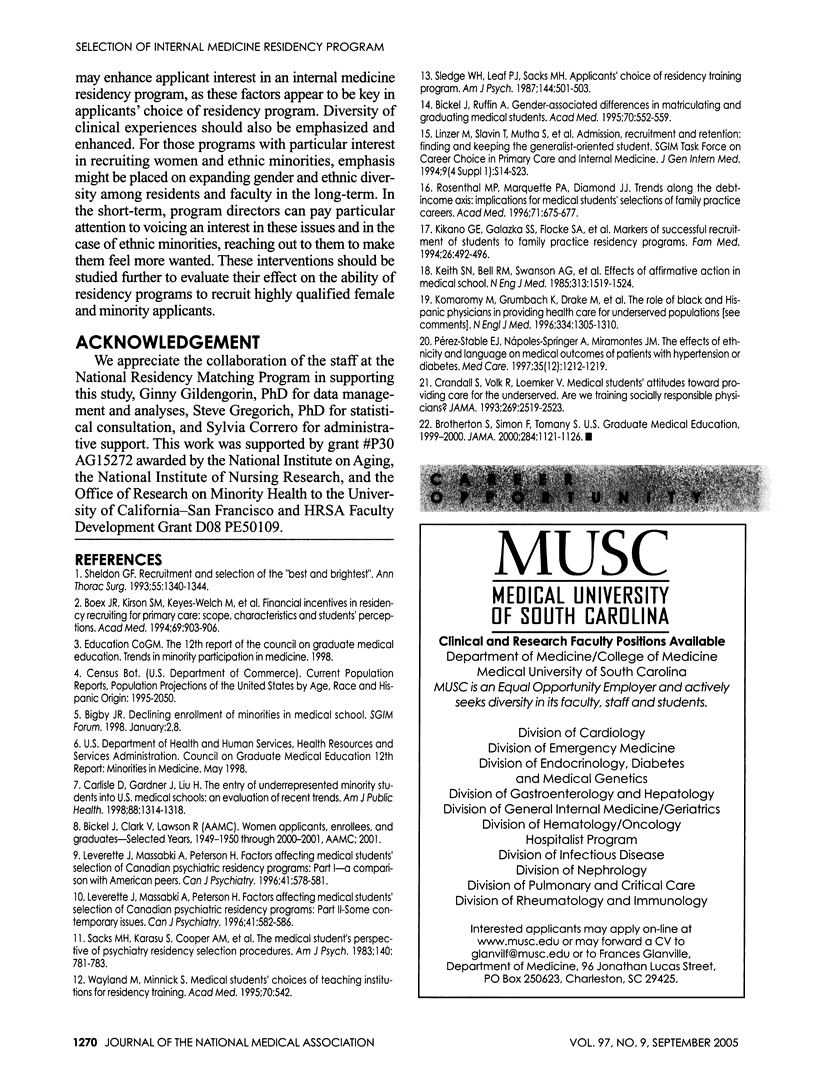
Selected References
These references are in PubMed. This may not be the complete list of references from this article.
- Bickel J., Ruffin A. Gender-associated differences in matriculating and graduating medical students. Acad Med. 1995 Jun;70(6):552–559. doi: 10.1097/00001888-199506000-00021. [DOI] [PubMed] [Google Scholar]
- Boex J. R., Kirson S. M., Keyes-Welch M., Evans A. Financial incentives in residency recruiting for primary care: scope, characteristics, and students' perceptions. Acad Med. 1994 Nov;69(11):903–906. doi: 10.1097/00001888-199411000-00012. [DOI] [PubMed] [Google Scholar]
- Brotherton S. E., Simon F. A., Tomany S. C. US graduate medical education, 1999-2000. JAMA. 2000 Sep 6;284(9):1121–1126. doi: 10.1001/jama.284.9.1121. [DOI] [PubMed] [Google Scholar]
- Carlisle D. M., Gardner J. E., Liu H. The entry of underrepresented minority students into US medical schools: an evaluation of recent trends. Am J Public Health. 1998 Sep;88(9):1314–1318. doi: 10.2105/ajph.88.9.1314. [DOI] [PMC free article] [PubMed] [Google Scholar]
- Crandall S. J., Volk R. J., Loemker V. Medical students' attitudes toward providing care for the underserved. Are we training socially responsible physicians? JAMA. 1993 May 19;269(19):2519–2523. [PubMed] [Google Scholar]
- Keith S. N., Bell R. M., Swanson A. G., Williams A. P. Effects of affirmative action in medical schools. A study of the class of 1975. N Engl J Med. 1985 Dec 12;313(24):1519–1525. doi: 10.1056/NEJM198512123132406. [DOI] [PubMed] [Google Scholar]
- Komaromy M., Grumbach K., Drake M., Vranizan K., Lurie N., Keane D., Bindman A. B. The role of black and Hispanic physicians in providing health care for underserved populations. N Engl J Med. 1996 May 16;334(20):1305–1310. doi: 10.1056/NEJM199605163342006. [DOI] [PubMed] [Google Scholar]
- Leverette J., Massabki A., Peterson H. Factors affecting medical students' selection of Canadian psychiatric residency programs: Part I--A comparison with American peers. Can J Psychiatry. 1996 Nov;41(9):578–581. doi: 10.1177/070674379604100906. [DOI] [PubMed] [Google Scholar]
- Leverette J., Massabki A., Peterson H. Factors affecting medical students' selection of Canadian psychiatric residency programs: Part II-Some contemporary issues. Can J Psychiatry. 1996 Nov;41(9):582–586. doi: 10.1177/070674379604100907. [DOI] [PubMed] [Google Scholar]
- Linzer M., Slavin T., Mutha S., Takayama J. I., Branda L., VanEyck S., McMurray J. E., Rabinowitz H. K. Admission, recruitment, and retention: finding and keeping the generalist-oriented student. SGIM Task Force on Career Choice in Primary Care and Internal Medicine. J Gen Intern Med. 1994 Apr;9(4 Suppl 1):S14–S23. doi: 10.1007/BF02598114. [DOI] [PubMed] [Google Scholar]
- Pérez-Stable E. J., Nápoles-Springer A., Miramontes J. M. The effects of ethnicity and language on medical outcomes of patients with hypertension or diabetes. Med Care. 1997 Dec;35(12):1212–1219. doi: 10.1097/00005650-199712000-00005. [DOI] [PubMed] [Google Scholar]
- Rosenthal M. P., Marquette P. A., Diamond J. J. Trends along the debt-income axis: implications for medical students' selections of family practice careers. Acad Med. 1996 Jun;71(6):675–677. doi: 10.1097/00001888-199606000-00024. [DOI] [PubMed] [Google Scholar]
- Sacks M. H., Karasu S., Cooper A. M., Kaplan R. D. The medical student's perspective of psychiatry residency selection procedures. Am J Psychiatry. 1983 Jun;140(6):781–783. doi: 10.1176/ajp.140.6.781. [DOI] [PubMed] [Google Scholar]
- Sheldon G. F. Recruitment and selection of the "best and brightest". Ann Thorac Surg. 1993 May;55(5):1340–1344. doi: 10.1016/0003-4975(93)90086-w. [DOI] [PubMed] [Google Scholar]
- Sledge W. H., Leaf P. J., Sacks M. H. Applicants' choice of a residency training program. Am J Psychiatry. 1987 Apr;144(4):501–503. doi: 10.1176/ajp.144.4.501. [DOI] [PubMed] [Google Scholar]
- Wayland M., Minnick S. Medical students' choices of teaching institutions for residency training. Acad Med. 1995 Jun;70(6):542–542. doi: 10.1097/00001888-199506000-00018. [DOI] [PubMed] [Google Scholar]


